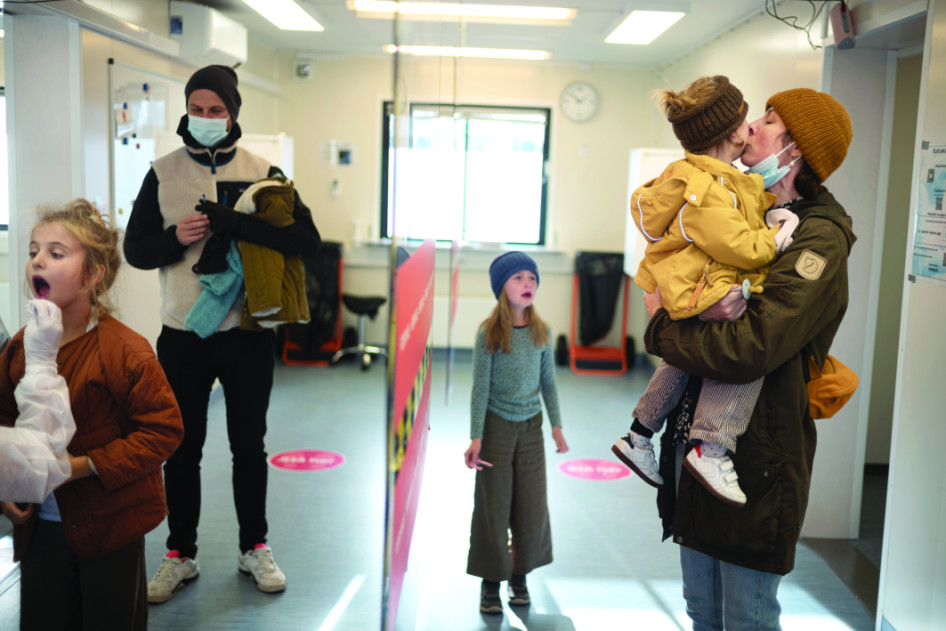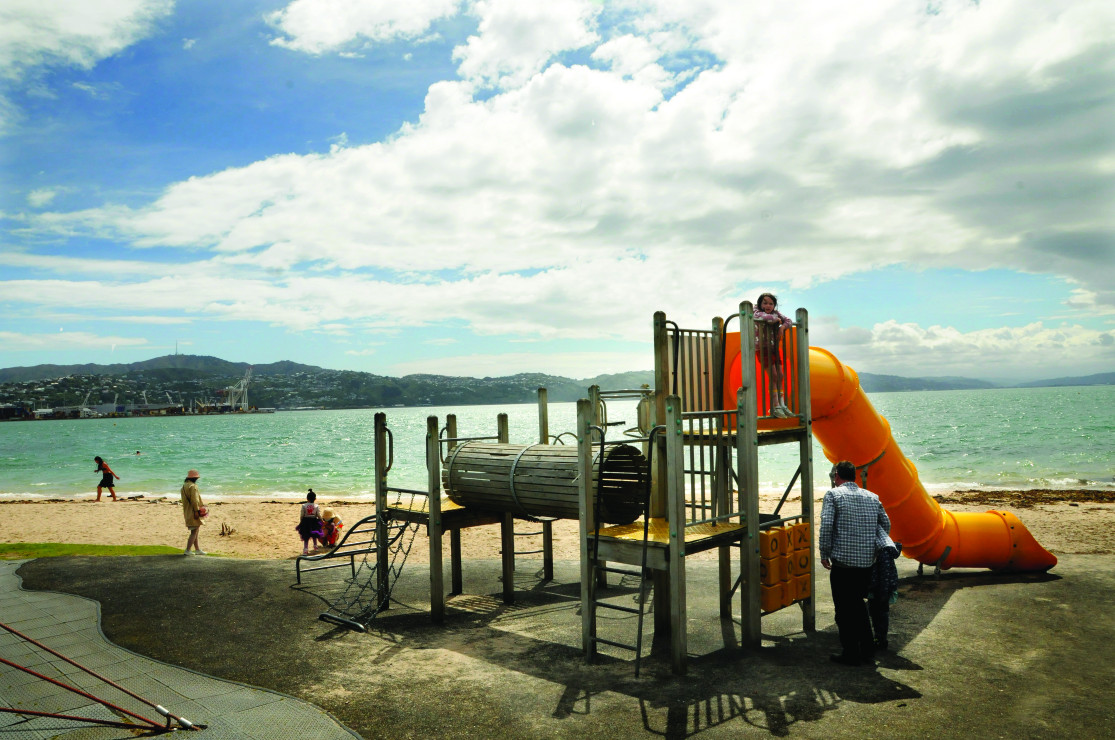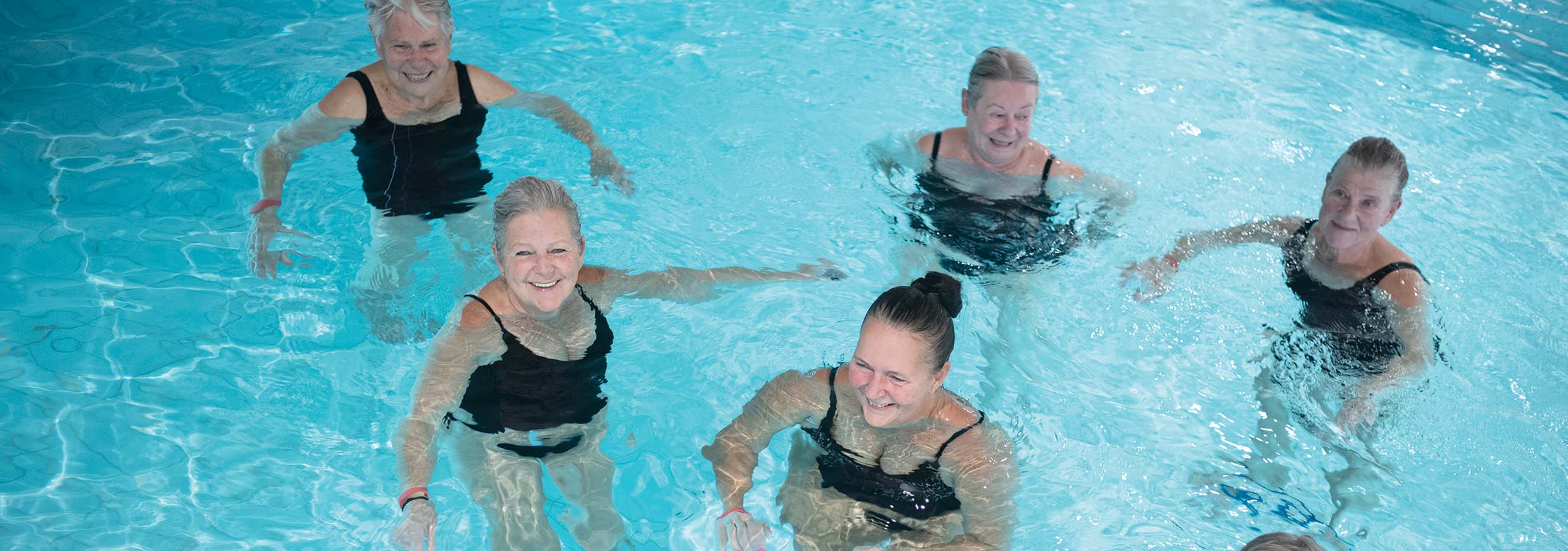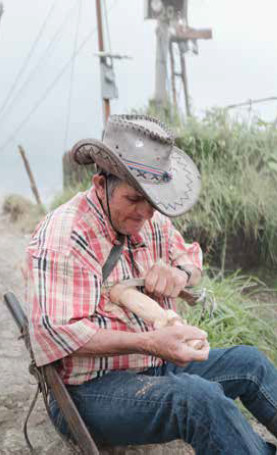Three countries provide lessons for improving health and promoting happiness
Denmark, Costa Rica and New Zealand stand out as three countries that are getting something right when it comes to maintaining the health and happiness of their citizens.
Case studies show that effectively delivering services at the community level, cultivating social trust, and accounting for well-being at the highest policy level all play an important role.
Living amid the despair caused by a global pandemic has taught us that happiness, as we know it in its many forms, is important for the functioning of societies.
“I’m with Aristotle on this one. Happiness, or a thriving life—or as the ancient Greeks called it, eudaimonia—is the summum bonum, the highest good,” says Columbia University economist Jeffrey Sachs, who coauthors the annual World Happiness Report, which ranks countries based on life evaluation surveys.
Denmark: It’s a matter of trust

A DANISH FAMILY AT A COVID-19 TESTING SITE. (PHOTOS: SOFIA BUSK)
By her own count, Cordelia Chesnutt has taken at least 32 COVID tests. A negative test was a requirement each time she wanted to pursue her side passion of playing badminton once Denmark lifted its lockdowns.
The tests, free and easy to schedule, were a small price to pay, she said, for ensuring the safety of others and, especially, maintaining a bit of happiness during the pandemic. It was also, to a large extent, an example of how many people in Denmark see their actions as a part of a collective effort.
Whether it’s based in enlightened self-interest or pure altruism, social trust is paramount in Denmark. Citizens trust that the government will enact policies in the public’s interest. Government trusts that citizens will maintain the social fabric. People trust that their fellow Danes will do what is required for the greater good. This social phenomenon played out during the pandemic, leading to a remarkably successful effort at stemming the virus at a relatively low human cost.
“It’s that I want to be safe, and it requires that everyone else follows the same rules and we trust that our government won’t go too far,” says Chesnutt, a 36-year-old Dane who works as a consultant on refugee issues.
Researchers often point to trust as the most important cultural trait when explaining Denmark’s consistent top rankings on various measures of happiness and contentment. Rooted within society’s trust is the country’s robust social welfare system, providing generous unemployment, free health care and higher education, and heavily subsidized childcare.
“Essentially with all the social support from the government, you’re redistributing a lot of money to strangers, and we know people are not likely to vote for that kind of system if they don’t have at least some degree of trust in strangers,” says Christian Bjørnskov, a professor of economics at Denmark’s Aarhus University.
Bjørnskov, who recently published a book called Happiness in the Nordic World, said the cultural trait of trust is almost unique to Danish and other Nordic societies. But he argues that it’s not necessarily the extensive social welfare that makes Danes content or happy but rather a combination of trust, tolerance, strong institutions, a long history of economic development, and a resilient democracy.
In at least one Danish town, officials have used happiness as a measure for setting an agenda. In 2014, the council of the picturesque fishing village of Dragør, near the capital city of Copenhagen, acted on a survey of its residents.
“We wanted to see what our community’s priorities are, what are their dreams and, basically, what makes them happy,” says Eik Dahl Bidstrup, who was mayor at the time.
The study, done in conjunction with the Denmark-based Happiness Research Institute, found the town’s citizens wanted better infrastructure for their leisure time. The research resulted in the construction of a new indoor swimming center, improvements to the town’s sports facilities, more programming for senior citizens, and improvements to public space in the town’s historic center and harbor.
“It’s a lot about work-life balance. Work is very important to us, but our free time is just as important. It’s an important priority for the community leaders to make sure there are good facilities, good possibilities for people to use their spare time,” says Bidstrup, now the chairman of Krifa, a Danish labor union.
A lack of corruption is also key to a high level of trust.
“We don’t have a corrupt political system. Most people have confidence in the political system,” says Mogens Lykketoft, a member of the Danish Parliament who in the 1990s oversaw major tax and labor reforms as the country’s longest-serving finance minister.
It is this lack of corruption, a long tradition of consensus building (no single party has held a majority since the early 1900s), and general efficiency of government services that allow most people in Denmark to accept high tax rates, he said.
“There is also underlying understanding of the fact that what the government provides in services for education, childcare, old-age care, health is more or less a contribution either to the efficiency of the business community or to the efficiency of the labor market,” Lykketoft says.
Still, the system faces challenges. Difficulties integrating immigrants and refugees into the labor market and the perceived strain on the social welfare system have been an argument for reducing social benefits, Lykketoft concedes. Although the government has put in place initiatives to address this challenge, the resulting debate over immigration has eroded trust in some corners of society.
During the pandemic, however, the country remained united, and policies to contain the virus averted the politicization that plagued many other democracies.
Michael Bang Petersen, a professor of political science at Aarhus University, led a data-driven project looking at how democracies reacted and coped with the pandemic. The project surveyed more than 400,000 people in Denmark and seven other countries. It showed that high and stable trust in Denmark’s health authorities was a key reason for the country’s success. More than 75 percent of eligible citizens as of late October were fully vaccinated. At the height of the pandemic, more than 60 percent of the adult population was being tested each week.
“I was a little bit worried when the test system was being rolled out. Is this something that people will see as an infringement on their rights?” Petersen says. “People instead saw it as something you did for each other. I’m being tested not because the state says that I need to be tested, but I am being tested so that I protect you, so that we can get back to a normal way of life much faster.”
The experience from the pandemic has only reinforced the country’s overall high levels of trust both in terms of people trusting the government (the survey found over 90 percent of Danes trust national health authorities) and vice versa.
“There is increasing evidence that there is a tight relationship between the functioning of political institutions and social trust,” says Petersen. “Essentially you come to trust your fellow citizens when you know the political institutions in your country have your back if something goes wrong.”
Costa Rica: The pure life
Pura vida, the “pure life.” It’s an expression you’ll often hear in Costa Rica. One that represents the laid-back lifestyle the country is known for and gives a sense of why Costa Ricans are as happy as they are.
“If you are healthy, have work, and are able to spend time with friends and family, you are pura vida,” says Luis Alberto Vásquez Castro, a former congressman for Costa Rica’s Limón province.
The 2021 World Happiness Report ranks Costa Rica the 16th happiest place on earth. Aside from the Czech Republic it is the only emerging market economy listed in the top 20. For a middle-income country, that’s a lot of happiness per GDP dollar.
Professor Mariano Rojas, a Costa Rican economist attributes the country’s high well-being to strong social relationships and a sense of community. “People are warm; the pace of life is slower. It’s not a competitive society where everyone is trying to climb the career ladder.”
The country also has a strong welfare system. Costa Ricans have access to free education and a guaranteed state pension. It is the only country in Central America where 100 percent of the population has access to electricity and a source of drinking water.
It is also one of the few countries in the region that offers universal health coverage.
Costa Rica has prioritized public health for decades, investing heavily in targeting the most readily preventable kinds of death and disability. In the 1970s, the country spent more on health as a proportion of GDP than even some advanced economies, including the United Kingdom.
Those investments paid off. By 1985, the nation’s life expectancy was the longest in Latin America and matched that of the United States. Child mortality rates dropped from about 74 deaths per 1,000 in 1970 to 17 by 1989.
What sets Costa Rica apart, however, is its primary health care model.
Implemented in the 1990s, the model built on decades of experience with rural and community health programs, changing the culture of care delivery in the country. “It brings health to the communities,” says María del Rocío Sáenz Madrigal, Costa Rica’s former minister of health.
Every Costa Rican is assigned to an equipo básico de atención integral en salud (EBAIS)—a local primary health care team of physicians, nurses, and community health workers. Health workers visit each household annually in the area to which they’re assigned to assess needs. The data they gather are combined with electronic health records and used to set targets, track progress, and focus resources on higher-risk areas.
When the system was first introduced, EBAIS teams were sent to the country’s most medically underserved rural areas before expanding to urban centers. “That allowed the country to build a very robust information system on the determinants of health—the conditions in which people live,” says Sáenz Madrigal. “It goes beyond attending to the disease. Investment in health starts with improving the conditions and quality of people’s lives. It’s a very comprehensive vision of what health and wellness is.”
Evidence shows the model works. Life expectancy rose from 75 in 1990 to 80 (well above the US). An enviable health outcome, yet the country now spends less on health care as a percentage of GDP than the world average (7.3 percent versus 10 percent in 2017).
Rojas thinks access to primary care pays. “People who are happy live longer. That’s why you need to spend less. It’s not only that health contributes to happiness. Happiness contributes to health.”
So which comes first—happiness or health? Sáenz Madrigal thinks that’s the wrong question.
“We have in Costa Rica what we call a social pact,” she says. “Regardless of the government that comes in, the one that follows must put in one more brick. The mistake we make many times is to say, ‘Everything that the previous government did is useless.’ It costs more to replace a brick than to build on one. That requires long-term vision and political will.”
Costa Rica has had a long democratic history of leaders who have made well-being a government priority. In 1869, the country became one of the first in the world to make primary school education both free and compulsory. Cristina Eguizábal, a political science professor, believes “Costa Rica has always had a very enlightened elite.”
“Costa Rican elites have been wise enough to maintain a certain level of well-being through a very robust fight against poverty,” she says. “Even though income inequality has widened, the percentage of people living in extreme poverty has fallen—until the COVID-19 crisis hit. That sense of security, empowerment, and equality is very important.”
And how did they become so wise? “Enlightenment has a dose of self-interest,” explains Eguizábal. “In the 1970s the country had one of the highest deforestation rates in Latin America. Energy in Costa Rica is mostly from hydropower, and dams were drying up. The government changed course because if it didn’t, the country would lose power.” Today, Costa Rica is a global green pioneer. “The greener your environment, the more jobs,” adds Eguizábal.
There is not just one, but many good reasons to be happy in Costa Rica, it seems.
Castro, the former congressman, confirms this: “Before being born, a Costa Rican is guaranteed life, education, food, social security, and the fact that he/she will only learn about war through a film...that is a country pura vida!”
New Zealand: Changing the conversation on well-being

YGROUND IN WELLINGTON, NEW ZEALAND. (PHOTO: JENNY TREVELYAN)
In 2019, New Zealand’s Labor government, led by Prime Minister Jacinda Ardern, unveiled a budget aimed at tackling some of the long-term challenges the country faces in areas such as domestic violence, child poverty, and housing.
The so-called Wellbeing Budget 2019 set out to prioritize five key areas: mental health, child well-being, supporting the aspirations of the Māori and Pasifika populations, building a productive nation, and transforming the economy. It unveiled billions for mental health services and child poverty as well as record investment in measures to tackle family violence.
New Zealand, a nation of 5 million people, performs well in many measures of well-being relative to most other countries in the Organisation for Economic Co-operation and Development. But it is also among the worst for family and sexual violence, and child poverty is also a challenge. In 2020, up to 210,500 children lived in poverty (18.4 percent), according to New Zealand’s statistics agency.
A fundamental aspect of the country’s well-being approach is the recognition that all aspects of what constitutes a good life must be considered holistically, whether it’s access to health care and education or a strong sense of connection to one’s community.
“The good news is that the conversation has changed,” says Girol Karacaoglu, former chief economist at the New Zealand Treasury and now head of the School of Government at Victoria University of Wellington. He is also the author of the book Love You: Public Policy for Intergenerational Wellbeing.
“There’s a realization that we need to worry about other things than income. New Zealand has taken this very seriously, and Budget 2019 is a good example of that.” The budget acknowledged that health and the economy go hand in hand. Kirk Hope, chief executive of BusinessNZ, sees this as a positive step.
“A lot of the investment is going into the health system. We need to get good outcomes for those investments. Well-being is critical to business. You won’t have a very productive workforce without it.”
At the same time, a number of experts are saying that more work is needed to measure outcomes and empower communities.
“Process matters critically in achieving desired well-being outcomes—and the most important shift in process is the requirement to give communities more voice and resources to drive change,” says Karacaoglu.
“The types of issues we are dealing with cannot be sorted out from the center—the center needs to play a listening and supporting role.”
The shift toward a more holistic approach means a shift in the way government works on these issues and measures outcomes. A lot of work has to go into this process, and it takes time, says Dominick Stephens, Treasury’s current chief economist.
“We’re thinking more holistically about how to deliver better outcomes for people. But we’re also continuing to build our understanding of well-being. This is hard.”
Emily Mason, who has worked 20 years in social policy and runs a Wellington consulting firm called Frank Advice, says the measurement tools are there but the government isn’t making use of them.
“Well-being as a concept is the right one but you need measures and decision-making infrastructure to make it work. You need the wisdom of community and of what has gone before, and to link that to data measurement, looking at each individual over the course of their lifetime. At its heart, well-being is an individual thing.”
“We have that statistical ability, but we’re not making full use of it.”
Among other things, the budget included an investment of $NZ 1.9 billion in mental health and a particular focus on reducing child poverty, an area close to the prime minister’s heart.
Shaun Robinson, head of the New Zealand Mental Health Foundation, says a lot more needs to be done to deliver much-needed improvements in mental health. But the government is taking positive steps, including the introduction of early support services for mental health at GP practices and community centers.
“What we’re not doing is giving people the tools to take care of their own well-being and that of the people around them,” he says, adding that a recently unveiled 10-year mental health strategy does acknowledge this point and is a step in the right direction.
While some say the results of the well-being budget are yet to be seen, they also recognize the impact of the pandemic.
“Since 2019, the government has been consistent in its goals in subsequent budgets, despite being hugely challenged by COVID-19,” says Karacaoglu.
Maree Brown, director of the Child Wellbeing Unit in the Department of the Prime Minister and Cabinet, says COVID-19 “upped the ante. …The Child and Youth Wellbeing Strategy already had a strong focus on joined up responses to improve the well-being of children and young people with greater needs. COVID meant we had to redouble those efforts.”
The strategy, launched in August 2019, sets out a shared understanding of what young New Zealanders said they want and need for a strong sense of well-being, what the government is doing, and how others can help, Brown says.
She says local pandemic responses demonstrated the strengths that reside in communities—strengths the government should tap into.
“In the past, we’ve tended to design too many initiatives from the center. Increasingly, there’s a move to devolve resources and decision-making, to co-design with families and community stakeholders, and to resource Māori and other providers to develop solutions that work for their communities.”
“It’s a work in progress but absolutely the right direction to be moving in.”
Reported by ANALISA R. BALA, ADAM BEHSUDI, and ANNA JAQUIERY.
Opinions expressed in articles and other materials are those of the authors; they do not necessarily reflect IMF policy.












